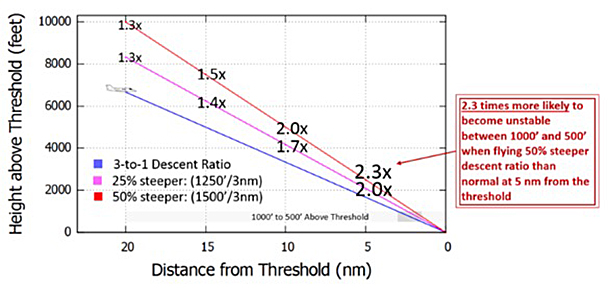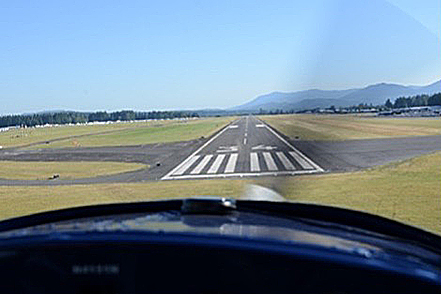Stabilized Approach and Landing
FAA Aviation Safety Safety Enhancement Topic
Focusing on establishing and maintaining a stabilized approach and landing is a great way to avoid experiencing a loss of control. A stabilized approach is one in which the pilot establishes and maintains a constant angle glidepath towards a predetermined point on the landing runway. It is based on the pilot’s judgment of certain visual clues, and depends on the maintenance of a constant final descent airspeed and configuration.
Maintain a Stabilized Approach
Have you heard these words before? Well, it’s not just a buzz term in aviation safety. It’s a critical lifesaving way to approach every flight. A pilot is flying a stabilized approach when he or she establishes and maintains a constant angle glidepath towards a predetermined point on the landing runway. Every runway is unique, but a commonly referenced optimum glidepath follows the 3:1 principle. The principle, also seen as a descent ratio, means that for every 3 nautical miles (nm) flown over the ground, the aircraft should descend 1,000 feet. This flightpath profile simulates a 3° glideslope.
Data Discourse
The Aviation Safety Information Analysis and Sharing (ASIAS) program, a collaborative government and industry initiative, recently completed a high-energy approach analysis by comparing actual stable and unstable approaches of business aviation operators to the common “3:1” descent ratio. The study looked at this relationship from four distinct distances from the runway: 20, 15, 10 and 5 nautical miles from touchdown. The study highlights the importance of being aware of how you manage the aircraft’s total energy — kinetic (velocity) plus potential (altitude) — as you begin to fly the approach. Flights that were above the 3:1 descent ratio, and not stable, often had high rates of descent and high approach speeds.
A deeper look at the analysis shows that, even at 20 nautical miles from touchdown, when a flight is above the optimum “3:1” descent ratio, the approach is more at risk of being unstable when closer to the runway (i.e., 500 feet to 1000 feet height above touchdown (HAT)).

Steep Descent Ratios Lead to Unstable Approaches
Moreover, the probability of being unstable can DOUBLE as you increasingly fly above a 3:1 flight path profile.
In addition, the data shows that at each of the distances (20, 15, 10, 5) when flying a 3:1 descent ratio, there is generally a 50/50 chance of being stable when reaching 500 to 1,000 HAT. Why 50/50? This is because your descent ratio is only one of many factors (such as aircraft configuration) that determine whether your approach will be stable or not.
Similarly, it’s important to recognize high kinetic energy states close-in to airports or near a final approach fix. Similar to descent ratios, the data demonstrates an increased risk potential if speeds during final vectors or approaches are not managed appropriately.

Bottom line: Be mindful of how you are flying an approach before you commence the approach, not just when you are close to the runway. Remember, one of the most effective ways to prevent becoming a statistic is to GO AROUND if something is not right at any time. If you choose to continue with an unstabilized approach, you risk landing too high, too fast, out of alignment with the runway centerline, or otherwise being unprepared for landing. These situations can result in loss of control of your aircraft or a runway excursion.
Important Tip: The further from the runway that you establish a 3:1 flight path profile, the greater your probability of successfully flying a stable approach. NOTE: Every runway is unique and the published glidepath should be flown when available.
https://www.youtube.com/watch?v=sSnuzXhEf6s&list=PL5vHkqHi51DQdF_PXKQT7uJUPd4UzlxNS
Tips for Staying Stable
- A method to estimate the appropriate descent rate in feet/minute to maintain a 3° glidepath is to multiply the groundspeed in knots by 5.
- When available, use a visual approach system such as a VASI or PAPI, or precision instrument approach to help maintain glidepath.
- Increase your knowledge on stabilized approaches. Some resources include the GAJSC website, Chapter 8of the FAA Pilot’s Handbook of Aeronautical Knowledge, Advisory Circular 91–79A, and a recent FAA FlySafe notice.
Reprinted with permission from FAA Safety Briefing. Visit the Flight Safety Briefing website:
https://www.faa.gov/news/safety_briefing/.



